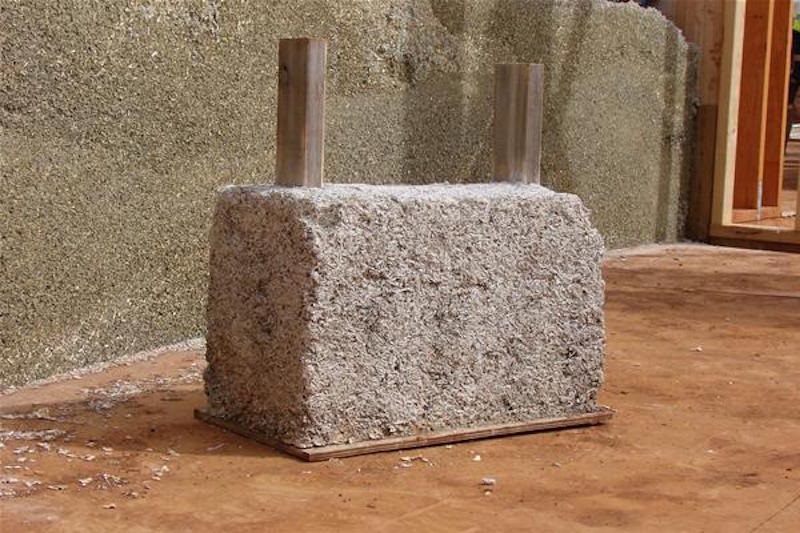Hempcrete
Contents |
[edit] Introduction
Hempcrete, also known as hemplime, is a bio-composite material that can be used in construction as an alternative to materials such as concrete and traditional insulation.
The basis of hempcrete is hemp, the balsa wood-like core (or ‘Shiv’) of a cannabis sativa plant. Hemp can be combined with lime and water to form hempcrete. The hemp has a high silica content, a unique property among natural fibres, which allows it to bind well with the lime. As a lightweight cementitious insulating material, it weighs only one-seventh to one-eighth that of concrete.
Hemp as a building material has been used across Europe for centuries, and as a modern building material, industrial hemp is now grown by certified commercial growers. The strain of plant grown for hempcrete contains 0.3% of THC, the ingredient in cannabis that provides its psychoactive nature. This is compared to the THC content found in hallucinogenic and medicinal varieties of between 5-10%.
While it is legally grown in Europe and Canada, growing hemp in America has been illegal for several decades. However, with the country’s gradual liberalisation of laws regarding the substance for medicinal and personal use, this may change.
[edit] Application
The material is mixed for 1-2 minutes before being applied, either into the wall cavities, or slip-forming with temporary timber or plastic shuttering. A hard render coating is generally applied as a finish on exterior surfaces with a thickness of around 20 mm. The interior can be left 'natural' or, for a traditional aesthetic, finished with lime plaster.
[edit] Properties
Hempcrete is very durable and has a number of other beneficial properties.
Similar to other natural plant products, carbon dioxide is absorbed from the atmosphere by hemp as it grows. During the curing process, as lime turns to limestone, the carbonation of the lime adds to this effect. As a result, hempcrete has a negative carbon footprint, with considerable potential for sustainable building.
It is able to naturally regulate a building’s humidity and temperature, which can reduce condensation and energy consumption, and improve thermal comfort for occupants. It provides natural insulation that is airtight, breathable and flexible. It is also toxin-free, impervious to mould and pests, and highly fire-resistant.
It is very suited to areas at risk of seismic activity since it is a low density material that is resistant to cracking under movement. The outer portion of the plant’s stalk can also provide fibres for building textiles.
However, hempcrete has a typical compressive strength of around 1 MPa, which is around 1/20 that of residential grade concrete, and has a density 15% that of concrete. This means that hempcrete walls must be used together with a load-bearing frame of another material.
[edit] Find out more
[edit] Related articles on Designing Buildings Wiki
- Blockwork.
- Cavity wall insulation.
- Cellular concrete.
- Composites.
- Concrete.
- Could the buildings of the future be made with bones and eggshells?
- Earth building.
- Floor insulation.
- Green building.
- Hemp lime construction: A guide to building with hemp lime composites.
- High alumina cement.
- K-Briq.
- Limecrete.
- Straw bale construction.
- Sustainability.
- Thermal insulation.
[edit] External resources
- American Lime Technology - What is hempcrete
Featured articles and news
Latest Build UK Building Safety Regime explainer published
Key elements in one short, now updated document.
UKGBC launch the UK Climate Resilience Roadmap
First guidance of its kind on direct climate impacts for the built environment and how it can adapt.
CLC Health, Safety and Wellbeing Strategy 2025
Launched by the Minister for Industry to look at fatalities on site, improving mental health and other issues.
One of the most impressive Victorian architects. Book review.
Common Assessment Standard now with building safety
New CAS update now includes mandatory building safety questions.
RTPI leader to become new CIOB Chief Executive Officer
Dr Victoria Hills MRTPI, FICE to take over after Caroline Gumble’s departure.
Social and affordable housing, a long term plan for delivery
The “Delivering a Decade of Renewal for Social and Affordable Housing” strategy sets out future path.
A change to adoptive architecture
Effects of global weather warming on architectural detailing, material choice and human interaction.
The proposed publicly owned and backed subsidiary of Homes England, to facilitate new homes.
How big is the problem and what can we do to mitigate the effects?
Overheating guidance and tools for building designers
A number of cool guides to help with the heat.
The UK's Modern Industrial Strategy: A 10 year plan
Previous consultation criticism, current key elements and general support with some persisting reservations.
Building Safety Regulator reforms
New roles, new staff and a new fast track service pave the way for a single construction regulator.
Architectural Technologist CPDs and Communications
CIAT CPD… and how you can do it!
Cooling centres and cool spaces
Managing extreme heat in cities by directing the public to places for heat stress relief and water sources.
Winter gardens: A brief history and warm variations
Extending the season with glass in different forms and terms.
Restoring Great Yarmouth's Winter Gardens
Transforming one of the least sustainable constructions imaginable.























